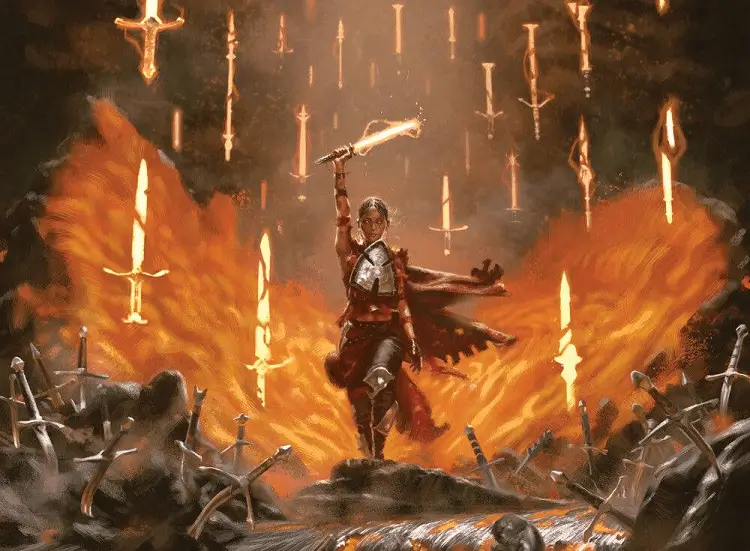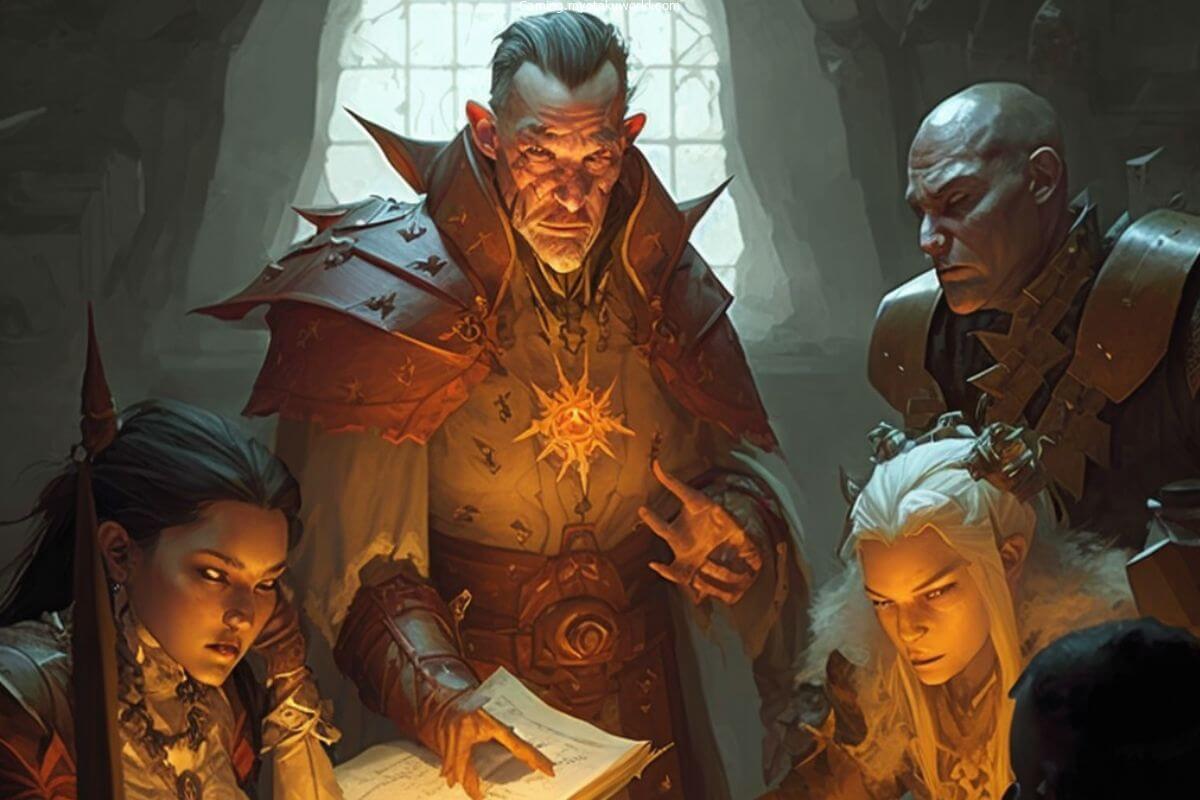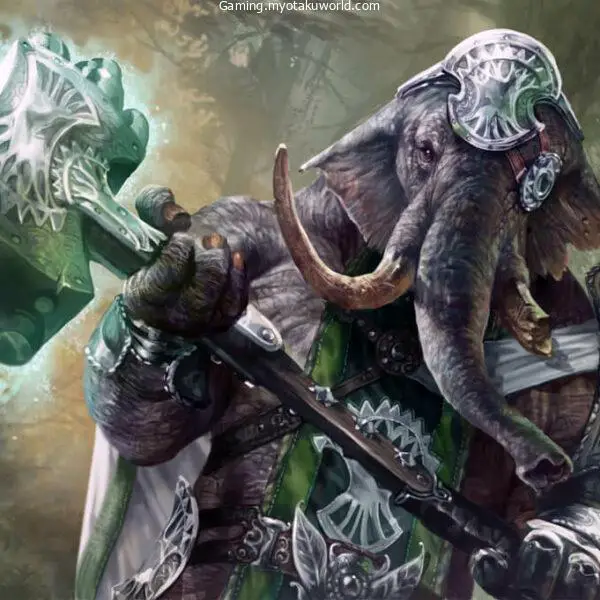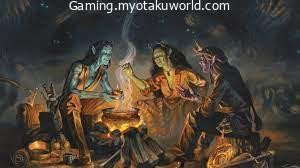On a quiet night in Faerun, the sounds of fighting broke the peace. Horns blew, drums beat, and cries filled the sky as the moon rose.
But when they saw their enemies, the orcs laughed.
Kobolds?
Kobolds are brave enough to attack orcs where they live? How stupid! Every orc is worth three kobolds.
They didn’t laugh for long, though.
Even though the orcs shot arrows and poked with spears, the impossible happened. Kobolds kept showing up!
Even worse, it looked like a lot of kobolds who had been hit by orc bullets and spears should have died but didn’t.
What is this dark magic? They don’t look like dead kobolds.
- How Inspiring Leader 5e Works
- Temporary Hit Points Table: Inspiring Leader
- Is Inspiring Leader Good?
- Duration of Temporary Hit Points
- No Limit
- Why Inspiring Leader Isn’t Overpowered
- Tiers of Play
- Inspiring Leader and Role-Play
- Is Inspiring Leader 5e Any Good?
- Which Classes Should Use It?
- FAQs
- If the Recipients of Inspiring Leader are Undamaged, can they not Hold onto their Temporary Hit Points for Weeks, Months, and even Years?
- Can the Temporary Hit Points of Inspiring Leader be Stacked with other Temporary Hit Point Boosters?
- Does the Inspiring Leader User Need to Actually Participate in the Upcoming Battle?
- Is it Possible for an Inspiring Leader to Inspire more than 300 Combatants?
How Inspiring Leader 5e Works

A character must spend 10 minutes making a speech to get their fellow adventurers ready for what’s to come.
In a fight, you can’t use Inspiring Leader because each round lasts six seconds. Also, your Inspiring Leader talent only affects six people at a time, no matter how many people listen to you. You are one of those six.
Listeners get temporary hit points equal to your level plus your Charisma modifier.
For example, if you’re playing a level 7 character with a Charisma score of 18, your bonus is +4. You could give each person 11 hit points for a short time.
Tip: Temporary hit points add to your normal hit points so you can stay awake longer. You lose temporary hit points when you take damage.
Once you use this feat, you can’t give those same six people temporary hit points again until they finish a short or long rest.
Even if they lose their temporary hit points in fight, your Inspiring Leader feat won’t give them any more until they’ve rested. But with this skill, you can give other people hit points for a short time.
Temporary Hit Points Table: Inspiring Leader
I made this temporary hit point table so that you and your friends don’t have to do too much Inspiring Leader math.
The character’s level is shown on the X-axis. The character’s Charisma modifier is shown on the Y-axis.
In parentheses are the real Charisma scores that would have that modifier. The numbers in the cells show how many temporary hit points the character’s “Inspiring Leader” speech gives to those who hear it.
| Level (rows) + CHA Modifier (column) | +1 CHA (13) | +2 CHA (14, 15) | +3 CHA (16, 17) | +4 CHA (18, 19) | +5 CHA (20) |
| 4th level | 5 | 6 | 7 | 8 | 9 |
| 5th level | 6 | 7 | 8 | 9 | 10 |
| 6th level | 7 | 8 | 9 | 10 | 11 |
| 7TH level | 8 | 9 | 10 | 11 | 12 |
| 8th level | 9 | 10 | 11 | 12 | 13 |
| 9th level | 10 | 11 | 12 | 13 | 14 |
| 10th level | 11 | 12 | 13 | 14 | 15 |
| 11th level | 12 | 13 | 14 | 15 | 16 |
| 12th level | 13 | 14 | 15 | 16 | 17 |
| 13th level | 14 | 15 | 16 | 17 | 18 |
| 14th level | 15 | 16 | 17 | 18 | 19 |
| 15th level | 16 | 17 | 18 | 19 | 29 |
| 16th level | 17 | 18 | 19 | 29 | 21 |
| 17th level | 18 | 19 | 20 | 21 | 22 |
| 18th level | 19 | 20 | 21 | 22 | 23 |
| 19th level | 20 | 21 | 22 | 23 | 24 |
| 20th level | 21 | 22 | 23 | 24 | 25 |
Wan Tei, the Yuan-ti pureblood sorcerer, has a Charisma score of 16 (+3) and is a 4th-level character.
At 4th level, she gets an ASI, which means that her ability score goes up. This will happen again at 8th, 12th, 16th, and 19th level. She can decide.
Normally, I would have her work on her Charisma and not let her buy any feats until her Charisma was at its highest level, which is 20.
Let’s say, though, that she leaves her Charisma at 16 so that she can buy the Inspiring Leader feat at 4th level.
The table shows how many temporary hit points she can give to anyone who hears her Inspiring Leader speech.
Level = 4 points. 16 Charisma + Charisma modifier = 3 points. Total = 7 hit points for a short time
Wan Tei will get another ASI when she gets to the 8th level. This time, since she already has the Inspiring Leader skill, she could put her ASI into Charisma and have 12 hit points, as shown in the table above:
Level 8 = 8 points. 18 Charisma + Charisma modifier = 4 points. Total: 12 hit points for a short time
Wan Tei would eventually be able to use Inspiring Leader to its full capacity, which is 25 temporary hit points.
Level 20 = 20 points. 5 (20 Charisma) + 5 (Charisma) = 5 points. Total: 25 hit points for a short time
Is Inspiring Leader Good?
Whether or not your DM thinks Inspiring Leader is a good feat and worth the cost of an ASI depends a lot on how he or she reads the above statement from the PHB on page 167.
On the surface, a feat that gives you 5–25 temporary hit points for up to 6 helpful creatures per short or long rest doesn’t seem worth the cost of an ASI when many spells can do the same thing.
If your DM thinks that the flaws listed above are the only things this feat can’t do, it’s not a good feat, and you shouldn’t choose it.
But as a DM, I take the limits of the definition very literally:
- Inspiration and temporary hit points take at least 10 minutes.
- 6/inspiration: Creatures
- Range: 30 feet maximum
- Comprehension means being able to understand and see or hear the boss.
- As shown in the table above, temporary hit points range from 5 to 25.
- Beneficiaries can get it again: 1. How long do you rest?
- Duration: normal for temporary hit points, which you can read about below.
- Number of ideas per day: No limit. (There are no limits except those that are set by tiredness and time. (Look down.)
Duration of Temporary Hit Points
On page 198 of the PHB, there is an area about temporary hit points. It says so.
“Features that give you temporary hit points last until they run out or you finish a long rest, unless they say otherwise.”
Since the description of Inspiring Leader doesn’t say how long it lasts, all of the people who benefit from it lose their temporary hit points after a long rest, even if they aren’t hurt.
No Limit
In the PHB, it says, “A creature can’t gain temporary hit points from this feat until it has finished a long rest.” It does NOT say how many times a boss can use this ability in a day.
In theory, a character with the Inspiring Leader skill could use it for an entire day of adventuring if he or she had nothing else to do. Example:
Wan Tei is a Wild Magic sorcerer with a level of 20 and a charisma score of 20. He also has the Inspiring Leader skill. So, per idea, she can give 25 hit points. For her, this is a speech. She wants to make a bunch of kobolds stronger.
At noon, six kobolds, each with 5 hit points, show up to hear her speech. Wan Tei gives her speech in Yipyak, the kobold language, because a friend has a spell that lets them understand languages.
Wan Tei’s speech takes 10 minutes, and when she’s done, each of the 6 kobolds has 30 hit points, which is 6 times more than they had before.
As soon as the 6 kobolds leave, 6 more kobolds with 5 hit points come in, and the same speech is given for another 10 minutes. Each of these six kobolds also leaves with 30 hit points.
The same thing happens over and over for two hours before Wan Tei gets a 30-minute break to rest, drink water, eat food, go to the bathroom, etc. In-game, it’s 2:30 pm when her break is over.
2 hours is 120 minutes, 12 inspiring talks are 72 inspired kobolds, and 1800 temporary hit points are gained.
Don’t be afraid. Wan Tei hasn’t even started yet!
Wan Tei will keep doing this for an 8-hour work day with two 30-minute breaks, and she will finish her speaking engagement at 10 pm. By 10 p.m., this is how the Inspiring Leader Math will look:
8 hours is 480 minutes, 48 inspiring talks are 288 inspired kobolds, and 7200 temporary hit points are earned.
If Wan Tei wants to join the fight herself, either as a spellcaster or a military leader, I, as the DM, would make her take a 1-hour break from her 8-hour speaking engagement. (Missing this short break would get you in trouble, just like missing the 30-minute breaks above.)
She could lead them into fight at 11 p.m., giving them about 7 hours to do their worst before dawn, which would be around 6 a.m. (Because Kobolds are sensitive to sunlight, they would lose if they fought during the day.)
If it takes time for the kobolds to move into place, Wan Tei can rest while the kobolds march and then teleport into the fight when it starts. If 7 hours of darkness isn’t enough time for her, she can start her talks before noon in the morning. If this fight is planned, the kobolds can change how they sleep in advance.
Having 288 kobolds in your army, each with 30 hit points, can really change the game. Their enemies would be surprised because they thought the kobolds would be easy to kill, not 6 times harder to kill.
If any kobolds lose their temporary hit points during this 7-hour battle, some of them can get them back if Wan Tei gives each group of 6 kobolds 10 minutes of her time and the combatants can take a 1-hour break from the battle (short rest) in addition to the 10 minutes for the speech.
If this Kobold Elite Battalion wiped out an enemy force, word would spread quickly, and Wan Tei’s job as a motivational speaker would be well on its way.
As a DM, this is how I would explain the boundaries of the Inspiring Leader skill. Based on how I see it, this is a good skill to have in the right situation.
Why Inspiring Leader Isn’t Overpowered
Even though Inspiring Leader lets you give temporary hit points to hundreds of fighters in a single sentence, I don’t think it’s too strong.
Why?
Let’s break things down to answer that question.
Why do DMs say that class abilities are too strong?
They worry that the game won’t be fair. They think the game will get too easy if the characters get too strong.
When asked about this problem, Matt Mercer, who is possibly the most well-known DM of our time, said that he just makes the monsters stronger.
Is that correct?
If the problem is just that the player characters aren’t strong enough to deal with the issues they face, then Mercer is right.
If you’re a DM and you think that the Inspiring Leader feat is too strong, you can give it to a kobold NPC and make the party always fight 30-hit-point kobolds.
Tiers of Play
On page 15 of the PHB, there is an area about Tiers of Play. With the Inspiring Leader skill, you can give 25 temporary hit points to other people. This makes you a 4th-tier character. What’s your value? As per PHB,
“During their adventures, the fate of the world or even the basic order of the multiverse might be in the balance.”
So, if Wan Tei, a 4th-tier character with 20 levels, wants to spend a whole day buffing up 288 kobolds for a single fight, the DM should be fine with that.
Most of the time, these kinds of characters have better things to do with their time than go on a speaking tour. Most players would also get tired of their speaking tour pretty quickly.
Inspiring Leader and Role-Play
As I said before, Inspiring Leader wouldn’t be worth picking if it were changed to 1 inspiration/1 long rest. The role-playing possibility is what makes it worth keeping in the game without being nerfed.
Think about what would happen if Wan Tei gave a speech to the kobolds in Yipyak. What would she really say to them?
If I’m the DM, the person playing Wan Tei has to give a real speech to me and the other players at the table. That’s playing a part!
Is Inspiring Leader 5e Any Good?
When you decide if a feat is good or not, there are a few things to think about. Some feats can only be used by certain classes, weapons, ways of fighting, or jobs in a group.
Others are generally thought to be good for everyone. Still others are usually forgotten by the D&D community because they are too weak or only useful in certain situations.
You have to decide if the feat is worth losing an Ability Score Increase for. You can only choose a feat at ASIs, with a few exceptions.
This means that the feat needs to be worth giving up +2 to one Ability Score or +1 to two Ability Scores. Even at low levels, Inspiring Leader is one of the few feats that people think is good enough to pay for.
With Inspiring Leader, you can give everyone in your party temporary hit points once a day.
Those hit points depend on your level and your Charisma modifier, so even if you’re only level 4 with a +2 Charisma modifier, you still give six people 6 temporary hit points every day.
Which Classes Should Use It?
Technically, the Inspiring Leader feat can be taken by any character type with a Charisma score of at least 13.
But the effects of the feat depend on your Charisma score, so characters with better Charisma scores can do more with it.
Since their spells are based on Charisma, Bards, Paladins, Sorcerers, and Warlocks are often the most charming members of a party.
But surprisingly, Rogues and Fighters are also good options because they have more chances to get feats. Fighters have seven different feats and Rogues have six.
Even if your Charisma score isn’t very high, you have many chances to take the feat, and it’s good enough to be worth the cost of an Ability Score Increase.
FAQs
If the Recipients of Inspiring Leader are Undamaged, can they not Hold onto their Temporary Hit Points for Weeks, Months, and even Years?
In my opinion, no. Even though this isn’t mentioned in the description of the Inspiring Leader feat, it is in the PHB’s part on temporary hit points.
Can the Temporary Hit Points of Inspiring Leader be Stacked with other Temporary Hit Point Boosters?
In general, no. Temporary hit points from Inspiring Leader don’t add up with temporary hit points from other class traits. But if there is a brief effect that gives hit points and says that it can be stacked, it would work with Inspiring Leader.
Does the Inspiring Leader User Need to Actually Participate in the Upcoming Battle?
As a DM, I would say no because the rules don’t say anything else. Wan Tei could just tell the kobolds that the upcoming fight is good for them and that they are sure to win because they are better than the enemy in many ways (numbers, merits, commanders, equipment, strategy, magic, etc.).
Is it Possible for an Inspiring Leader to Inspire more than 300 Combatants?
I think great things are possible if you plan your Inspiring Leader Math well. Wan Tei can choose not to fight and work a 16-hour day with few or no breaks instead.
Wan Tei could give her speech for a couple of days because her kobolds could do light work and skip long breaks in favor of several short ones. That’s metagaming, but metagaming is certainly a part of 5e.










Leave a Comment